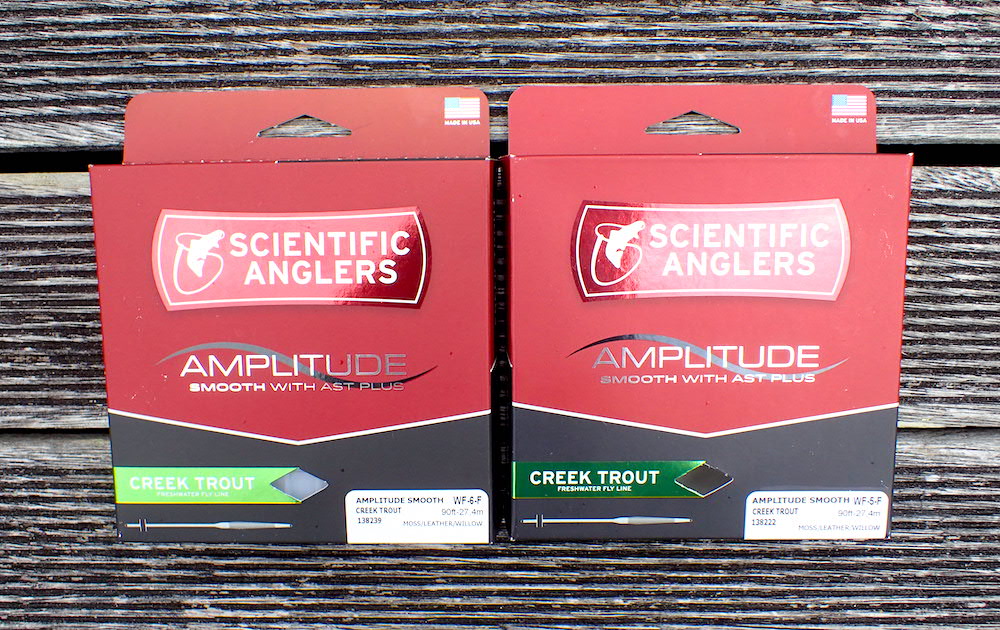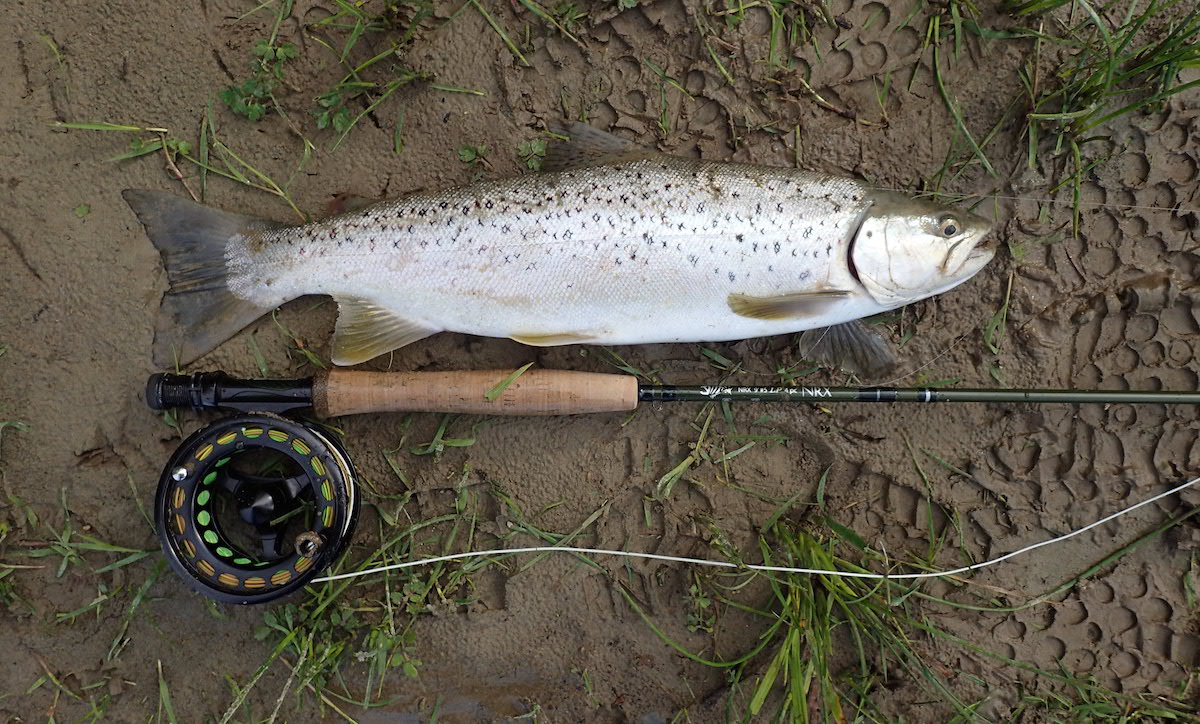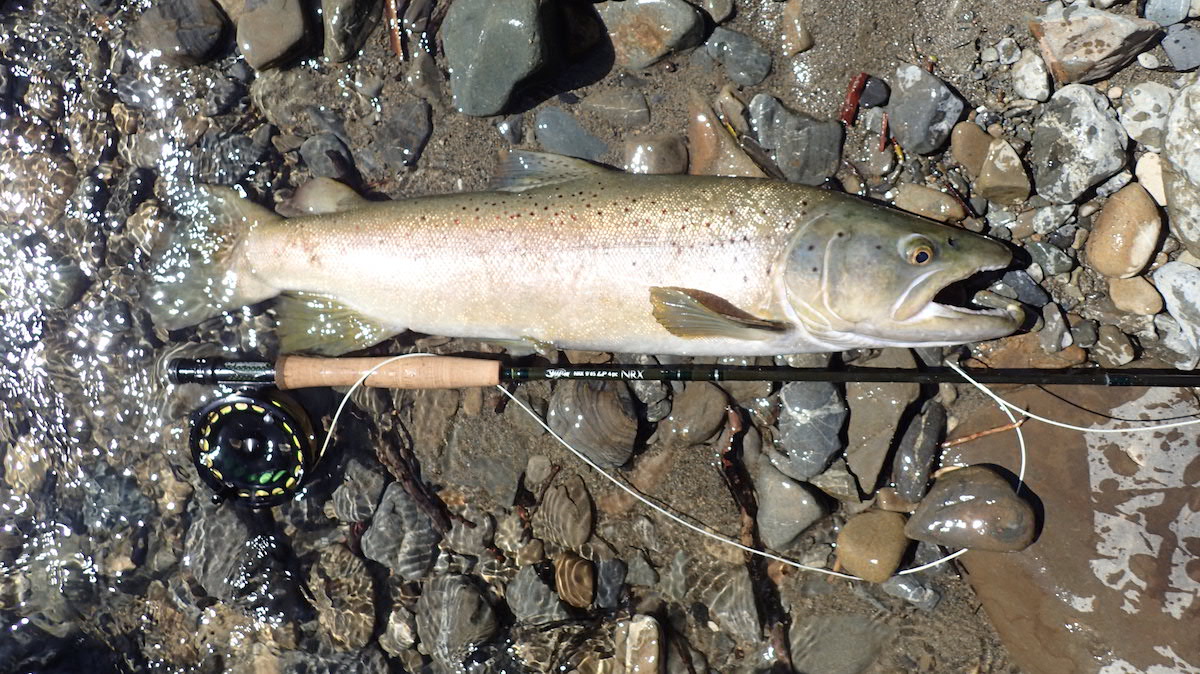The Creek Trout is an incredibly versatile floating line well suited to many angling scenarios in New Zealand - it is also a fantastically easy to cast, both overhead and Spey.

The Amplitude Smooth Creek Trout, released by Scientific Anglers in 2020, is designed for fishing small streams.
The line’s short head has a delta profile and is a full line size heavy to load rods quickly for short casts. Head length varies from 21.5 ft for the 2wt to 25 ft for the 6 wt.
What had me excited about the Creek Trout is that it’s essentially an integrated compact Scandi. While this is great for roll casting on overgrown small creeks with no room for a back cast, I was thinking single-hand Spey in general, especially fishing soft hackles and swinging dry flies and streamers.
I tested both the 5 and 6 weight Creek Trout lines. Although I don’t own a 6wt fly rod, I suspected, based on head weights, the 6 wt may make a better dedicated Spey line for a 5wt rod.
I tested both the Creek Trout lines on a few of my favourite 5 wt fly rods, including a Loomis Streamdance HLS, a Loomis NRX LP, a Douglas Sky G and a 9.5 ft Sage X, trying them in a range of fishing situations.
While the Creek Trout did not disappoint for Spey casting, it turned out to also be an incredibly versatile floating line for New Zealand conditions.
Profile and colour
The 5wt Creek Trout has a continuous front taper of around 21 ft (no level belly) and a more or less 3 ft rear taper that attaches to an extended 3 ft level handling section that tapers down to the running line. Colour-wise, the first 6.5 ft is willow, the remainder of the head is a medium brown (called leather) and the handling section and running line are moss green.
The head on the 6wt is a foot longer and the front taper a little more gradual, although the rear of the head is thicker.
Testing the weights on an electronic scale, the head of the 5wt weighed 162 grains and the 6wt 187 grains.
Like all Scientific Angler Amplitude fly lines, which have the AST Plus additive, the CreekTrout is very supple and super slick.
Casting
Overhead Casting
The Creek Trout series is incredibly fun to overhead cast, smooth tight loops are effortless, and it shoots like crazy.
Even though the head is short this does not mean that the Creek Trout is limited to short casts. In practice the Creek is an integrated shooting head capable of impressive distance, as in an easy 80 feet.
The rear and long front tapers slow and smooth turn over, extending flight time and improving presentation at distance.
I was initially surprised that the 5wt Creek did not feel like it was a full line size heavy, until I realised that since I usually aerialize much more than the first 30 ft of a regular fly 5wt line with a 40 ft head, my rods are commonly loaded with around 160 to 200 grains of fly line on the final delivery. The first 30 feet of the 5wt Creek weighs 160 grains, and one can’t aerialize much more than 26 feet without losing control of the cast.
The 6wt Creek provided a bit more load, but was not too heavy for a fast action 5wt rod.
Five and 6 wt fly lines with long continuous front tapers are usually at their best with small flies. However, the short heads on the Creek 5 and 6wts give these lines the grains per foot to cast some decent sized bugs, even on 15 ft leaders.
The 5wt had no trouble casting size 6 cicada imitations as well as size 8 woolly buggers with 11 turns of 0.25” lead wire. With the 6 wt I could push the size of the streamer up to a size 6 woolly bugger with a 4mm bead.
I found the 5wt and 6wt Creeks were at their best, both when casting and in presentation, with 12 - 15 ft leaders.
Spey Casting
The Creek Trout is an excellent Spey casting line and a brilliant single hand Scandi.
Fly lines with delta tapers are ideal for Spey casting as they place more weight in the upper portion of the D-Loop, where it’s most effective at loading the rod. Long front tapers result in smooth turn-over and great presentation.
As with overhead casting, the colour change between the head and handling section is extremely useful for Spey casting.
Based on general grain weight recommendations for Spey casting, I thought the 6wt Creek, with a 185 grain head, may be more suited to Spey casting on a 5wt single hand rod - but I was wrong. The 5wt Creek, with a slightly shorter 160 grain head, provides plenty of load for both water-loaded and touch-and-go casts; and its presentation with soft hackles and dry flies was noticeably better than with the 6wt.
As far as leaders are concerned, I found that fifteen foot tapered mono-leaders performed much better than 10 ft leaders when Spey casting soft hackles, dry flies and small streamers on the Creek, as the longer leaders provided more line stick. Presentation was also better with the longer leaders.
In terms of distance, I could not Spey cast the Creek Trout as far with dry flies and soft hackles as I could overhead cast it, but I found Spey casts of 40 to 60 feet from the rod tip to the fly were easy. The relatively thick running line (compared to the integrated Scandi Lite) made it difficult to shoot much more than 2 rod lengths of running line when Spey Casting light flies.
The additional line stick provided by a couple of tungsten nymphs and a small indicator allowed for greater distance, and Spey casts of 75 feet were no problem when nymphing.
Creek Trout vs Integrated Scandi Lite
If you’ve read my articles on Trout Spey you’ll know that the 150 grain integrated SA Scandi Lite has been my favourite Scandi style line for 9 ft 5wt rods. Sadly the 150 grain version was discontinued in 2022. I was therefore eager to see how the Creek Trout would shape up as a possible replacement.
I tested the 5wt and 6wt Creek Trout against both the 150 and 180 grain Scandi Lites.
On paper there are a number of differences between the 150 and 180 grain Scandi Lites and the 5wt and 6wt Creek Trout:
1. The Scandi Lite heads are 20 ft long while the 5wt and 6wt Creek Trout are 24 and 25 ft, respectively.
2. The Scandi Lite heads have a compound front taper - which is gradual for the most part but becomes more acute over the last 8 (180 grain) to 10 (150 grain) feet - whereas the Creek Trout has a continuous front taper.
3. The bellies are much thicker, but tips and the running lines are much thinner on the Scandi Lites.
On the water the 5wt Creek was smoother to cast than the 150 grain Scandi Lite, and it also had more nuanced mending ability due to the head profile and thicker running line. Presentation was also better with the Creek, especially with a 15 ft leader.
With the Scandi Lite I could shoot more running line when Spey casting, but because the head was 4 ft and the leader 6 ft shorter I didn’t achieve much more distance. Of course, the shorter head and leader meant that the Scandi Lite needed less back casting room. And with the textured interface between head and running line it was also easier to gauge the position of the head when Spey casting at night.
Overall I consider the 5wt Creek Trout a better general purpose line for fishing soft hackles and swinging dries and wet flies.
The 150 grain Scandi Lite nevertheless remains an excellent specialist line for the evening caddis hatch, when frequent mending and very delicate presentation is not required.
I find the 180 grain Scandi Lite a tad heavy for the average 5wt rod, and the powerful belly overpowers the skinny tip causing it to kick around when using a standard tapered leader and light flies.
The belly on the 180 grain Scandi Lite also lands before the tip, with a considerable splash. In fact it casts more like a Skagit head with a floating tip attached to it.
I find the 6wt Creek a far smoother casting line, and presentation a million times better than with the Scandi Lite. It’s therefore a much better bet for fishing soft hackles, swinging dries and emergers, and casting lighter streamers on a 6wt single hand rod.
More grains per foot do, however, give the 180 grain Scandi Lite the ability to cast 7 ft Sonar leaders and heavier streamers, which also happen to straighten the tip and improve presentation.

Fishing
Fishing Small Streams
The Creek Trout does everything well on small/medium streams: dry flies, nymphs, streamers, overhead casting, roll casting - there are not limits.
Fishing Larger Rivers
Although the Creek Trout was designed for small streams it excels in many different fishing situations on larger rivers, just not all.
Indicator nymphing
The Creek can certainly do the distance on larger rivers, but the limitation of a short shooting head is that one can’t mend all the way to an indicator with casts longer than about 50 feet. One can easily throw an aerial mend to deal with a fast current 30 ft out on a 70 ft cast, but will struggle to re-position the head upstream of the indicator - at least until the indicator has drifted to within 50 ft of the rod tip.
Therefore I don’t consider the Creek Trout an ideal line for indicator nymphing at distance on larger rivers.
This doesn’t mean one can’t prospect riffles and current seams with accurate 60 ft casts. And within 50 feet the Creek Trout mends incredibly well owing to the delta taper of the head.
Hatches
The ability to make quick and accurate casts with good presentation makes the Creek a great line for dry fly hatches on rivers of all sizes.
Whether fishing mayflies dead drift, or swinging caddis flies, casts longer than 50 feet are generally counter productive, as they are less accurate and usually cross multiple current lanes causing drag or unnatural action that results in refusals or missed fish.
Using a 15 ft leader for mayfly hatches results in a delicate presentation and some slack to counter drag. In fact a 15 ft leader is often mandatory on New Zealand rivers during low flow, e.g. the Mataura River.
Sight fishing
The Creek is a great line for casting nymphs and dry flies to fish spotted on crystal clear NZ rivers. Accuracy and presentation, including the ability to turn over a 15 ft leader, count for a lot in these situations, and less false casting often means fewer fish spooked.
I was surprised to find that the 5 wt Creek Trout easily turns over a size 6 cicada pattern on a 15 ft leader, and that accurate 25 - 60 ft casts were easy with the big dry fly. Unlike many other fly lines, the Creek will deliver a big cicada with only a rod’s length of fly line outside of the tip-eye, so accurate 25 ft casts (often necessary on backcountry rivers) are easy.
The 5 wt Creek can easily manage a couple of tungsten bead nymphs below a small poly-yarn indicator on a 15 foot leader. The heaviest combination I tried was a 3mm tungsten bead on the dropper and 2mm on the point.
Mending at range is usually not an advantage when sight fishing, as casts are not overly long and one usually positions oneself so that no mending is required during the relatively short drift onto the fish. The occasional long cast over faster near shore currents is, however, not a problem, as aerial mending is easy with the Creek.
Spey Casting
There are many places on larger rivers where back casting room is limited, and Spey casting is an advantage. Other advantages of Spey casting, apart from the fun, are fewer tangles with multi fly rigs and less tail-wrap with streamers having mobile tails.
For the Spey casting addict, the Creek Trout is a fantastic line for fishing soft hackles, swinging caddis dries and emergers during the evening caddis hatch and fishing small streamers through shallow riffles and runs. Apart from its ability to handle 15 ft leaders, the incredible mending ability and line control of the Creek (on casts 50 feet or less) make it an especially good choice for soft hackles.
It is incredibly easy to switch between Spey and overhead casting, and with a single Spey, a double spey or a peri poke, you can send a couple of tungsten bead nymphs 70 or 80 ft without a single false cast over the fish.
Fishing Lakes
The Creek would be a great line for stalking lake shores and fishing streamers and nymphs over weed beds or in shallow stream mouths. Presentation is good and its easy distance with less false casting means more time with the fly in the water, as well as less tangles at night. The Creek’s short head and Spey casting ability are also an advantage when back casting room is limited, e.g. on Lake Otamangakau.
A line that loads short and casts long is also an advantage when wading deep or sitting in a float tube. Attempting to aerialize too much line in these situations results in flies clipping the water on the back cast.

Final Word
While the Creek is designed as a specialist line for small water, it’s turned out to be an incredibly versatile floating line that does a lot of things well.
It’s short enough to turn over decent sized flies on a 15 ft leader with minimal false casting, is long enough to mend effectively out to 50 ft, and as a shooting head will cast for miles. The long front taper makes for great presentation and pure casting joy - both for overhead and Spey.
The Creek is such an easy fun line to cast I would highly recommend it for anyone learning to fly cast, either overhead or Spey.
I see myself using the Creek Trout for many angling scenarios in New Zealand.
Thanks to Kilwell Sports, New Zealand, for providing the Creek Trout lines for testing.
